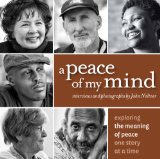Peace is a popular term this time of year. You know, “Peace on Earth” and the like. But what does peace mean? Even dictionary definitions show it has varying meaning. Perspective is important. Do we view things externally as in there being no armed conflict, as an internal state of mind, or must both exist for there truly to be peace?
 Because each of us likely has our own definition and perspective, in early 2009 John Noltner began interviewing people about what peace meant to them. His goal was to create a collection of thoughts on peace from a wide variety of people and use it to foster a larger public conversation about the topic. A freelance photographer based in Minneapolis, Noltner also took black and white portrait photographs of his subjects. In addition to creating a traveling exhibit, another result of his efforts is his book, A Peace of My Mind, Exploring the Meaning of Peace One Story At a Time, which contains excerpts of about 50 interviews and the subjects’ portraits. (Many of the full interviews are available on the book’s web site as podcasts.)
Because each of us likely has our own definition and perspective, in early 2009 John Noltner began interviewing people about what peace meant to them. His goal was to create a collection of thoughts on peace from a wide variety of people and use it to foster a larger public conversation about the topic. A freelance photographer based in Minneapolis, Noltner also took black and white portrait photographs of his subjects. In addition to creating a traveling exhibit, another result of his efforts is his book, A Peace of My Mind, Exploring the Meaning of Peace One Story At a Time, which contains excerpts of about 50 interviews and the subjects’ portraits. (Many of the full interviews are available on the book’s web site as podcasts.)
A significant number of those interviewed, particularly those with a religious orientation, tend to look toward an internal peace as a first and essential step. They believe that the personal effort of finding an inner peace contributes to and builds peace in the world as a whole. Others tend to view it as an absence of war. Yet there hasn’t been much of that, notes Luyen Phan, an international student advisor. He believes peace can arise by building on cultural awareness and exchanges so that what happens elsewhere in the world has more meaning to us.
Economic and personal security also play a role in some visions of peace. Some express the concept that “nobody gets seconds until everyone gets firsts” or that the measure of success isn’t monetary but the intangible values that prompt people to strive to help others. There is also a sense in some interviews that personal safety or the knowledge that a person has food and shelter are key components.
Some views are striking because of the individual’s background. Jamal Hashi was in elementary school when war broke out in his native Somalia. Now a restaurant owner, his observations have a somewhat unique religious backdrop and perspective.
The core of the message [in the Bible and Qur’an] is: achieve peace, give peace, and live by peace. But what do we fight about? The difference of who was the messenger. It’s like killing the mailman because he wasn’t the same mailman last week. Did you get the mail? That’s all that matters.
Others are more lyrical. Take for example, Melvin Carter Jr., a retired St.Paul police officer, who considers peace it “living symphonically” with each other. “[Y]ou know, in the symphony you’ve got all kinds of stuff happening — rhythmically and melodically and harmoniously — at the same time. [Yet the instruments work] together in such a way that doesn’t clash.”
One thing that is clear is that regardless of how people view or strive for peace, it is not a state we should consider only during particular times of the year. Thus, A Peace of My Mind would be one of those Christmas gifts that has the propensity to long outlast the event.
I would love to live in a society with people who are addicted to peace. Wouldn’t that be one hell of an addiction?
Hudlin Wagner in John Noltner’s A Peace of My Mind







